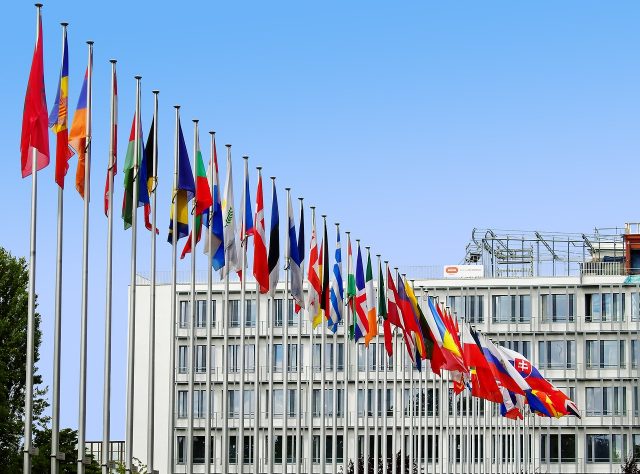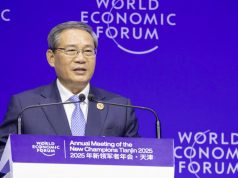IMF World Economic Outlook 2023: Global GDP to Grow 2.8% in 2023, United States +1.3%, China +5.2%, Challenging Outlook with Downside Risks, High Interest Rates, Rising Level of Debt, Economic Fragmentation & Impact on Foreign Direct Investment
22nd April 2023 | Hong Kong
The International Monetary Fund (IMF) has released the IMF World Economic Outlook 2023, with global GDP growth forecast to grow +2.8% in 2023 (2022: +3.4%) and +3% in 2024. The IMF World Economic Outlook 2023 titled “A Rocky Recovery”, highlighted a challenging global outlook with downside risks, impact of high interest rates, rising level of private & public debt, and economic fragmentation (trade tensions, supply chains) & impact on foreign direct investment. 2023 GDP Growth forecast: United States +1.3%, UK -0.3%, China +5.2%, India +5.9%, Hong Kong +3.5%, Singapore +1.5%, Indonesia +5%, Malaysia +4.5%, Thailand +3.4%, Australia +1.6%. View key findings & summary below.
“ IMF World Economic Outlook 2023: Global GDP to Grow 2.8% in 2023, United States +1.3%, China +5.2%, Challenging Outlook with Downside Risks, High Interest Rates, Rising Level of Debt, Economic Fragmentation & Impact on Foreign Direct Investment “
IMF World Economic Outlook 2023

The International Monetary Fund (IMF) has released the IMF World Economic Outlook 2023, with global GDP growth forecast at +2.8% in 2023 (2022: +3.4%) and +3% in 2024. The IMF World Economic Outlook 2023 titled “A Rocky Recovery”, highlighted a challenging global outlook with downside risks, impact of high interest rates, rising level of private & public debt, and economic fragmentation (trade tensions, supply chains) & impact on foreign direct investment. View key findings & summary below.
2023 GDP Growth forecast in Americas:
- United States: +1.3%
- Canada: +1.5%
- Brazil: +0.5%
- Mexico: +1.8%
2023 GDP Growth forecast in Europe:
- United Kingdom: -0.3%
- Germany: 0.1%
- France: +0.7%
- Italy: +0.7%
- Spain: +1.5%
- Switzerland: +0.8%
- Netherlands: 1%
- Denmark: 0%
- Russia: +0.7%
2023 GDP Growth Forecast in APAC:
- China: +5.2%
- India: +5.9%
- Japan: +1.3%
- Hong Kong: +3.5%
- Singapore: +1.5%
- Indonesia: +5%
- Malaysia: +4.5%
- Thailand: +3.4%
- Philippines: +6%
- Vietnam: +5%
- Australia: +1.6%
- New Zealand: +1.1%
- South Korea: +1.5%
- Taiwan: +2.1%
- Macao: +58.9%
2023 GDP Growth Forecast in Middle-East & North Africa:
- Saudi Arabia: +0.1%
- Qatar: +2.4%
- UAE: +3.5%
- Egypt: +3.1%
- Iraq: +3.7%
- South Africa: +0.1%
- Nigeria: +3.2%
2023 GDP Growth Forecast
- Advanced Economies: +1.3%
- Emerging Market and Developing Economies: +3.9%
Top 10 Economies in the World (GDP):
- United States – $23 trillion
- China – $17.7 trillion
- Japan – $4.9 trillion
- Germany – $4.2 trillion
- United Kingdom – $3.2 trillion
- India – $3.2 trillion
- France – $2.9 trillion
- Italy -$2.1 trillion
- Canada – $2 trillion
- South Korea – $1.8 trillion
Top 15 Economies in Asia-Pacific (GDP):
- China – $14.72 trillion
- Japan – $5.06 trillion
- India – $2.66 trillion
- South Korea – $1.63 trillion
- Australia – $1.54 trillion
- Indonesia – $1.19 trillion
- Taiwan – $775 billion
- Thailand – $505 billion
- Bangladesh – $416 billion
- Singapore – $397 billion
- Philippines – $394 billion
- Malaysia – $373 billion
- Hong Kong – $368 billion
- Vietnam – $366 billion
- Pakistan – $348 billion
IMF World Economic Outlook 2023
1) Global Prospects & Policies
- Global economy at a highly uncertain moment, COVID-19 pandemic, Russia’s invasion of Ukraine manifesting in unforeseen ways, Pent-up demand, lingering supply disruptions, commodity price spikes, inflation reached multi-decade highs
- Central banks tighten (monetary policy – interest rate, money supply) aggressively and manage inflation
- Rapid rise in interest rates and anticipated slowing of economic activity to put inflation on a downward path have, supervisory and regulatory gaps, bank-specific risks, contributed to stresses in parts of the financial system, raising financial stability concerns.
- Banks’ generally strong liquidity and capital positions can absorb the effects of monetary policy tightening
- Financial institutions with business models that relied heavily on a continuation of the extremely low nominal interest rates have come under acute stress
- Unexpected failures of 2 specialized regional banks in the United States in mid-March 2023 and the collapse of confidence in Credit Suisse roiled financial markets, with bank depositors and investors reevaluating the safety of their holdings and shifting away from institutions and investments perceived as vulnerable
- Financial conditions have tightened, which is likely to entail lower lending and activity if they persist
- Uncertainty is high, and the balance of risks has shifted firmly to the downside so long as the financial sector remains unsettled.
- Central banks’ tight monetary stances to allay inflation, limited fiscal buffers to absorb shocks amid historically high debt levels, commodity price spikes and geo-economic fragmentation with Russia’s war in Ukraine, and China’s economic reopening – seem likely to continue into 2023
- A hard landing, particularly for advanced economies has become a much larger risk
- Policymakers may face difficult trade-offs to bring sticky inflation down and maintain growth while also preserving financial stability.
Inflation, Interest Rate
- Global headline inflation has been declining since mid-2022 at a 3-month seasonally adjusted annualized rate.
- Both headline and core inflation rates remain at about double their pre-2021 levels on average and far above target among almost all inflation-targeting countries.
- Major central banks have generally stayed firm in their communications about the need for a restrictive monetary policy stance, signalling that interest rates will stay higher for longer than previously expected to address sticky inflation.
High Private & Public Debt
- As a result of the pandemic and economic upheaval over the past three years, private and public debt have reached levels not seen in decades in most economies and remain high
- Monetary policy tightening, particularly by major advanced economies, has led to sharp increases in borrowing costs, raising concerns about the sustainability of some economies’ debts.
- Economies at high risk of debt distress remains high in historical context, leaving many of them susceptible to unfavorable fiscal shocks in the absence of policy actions
Commodity Shocks Unwinding Despite Russia’s War in Ukraine Persists
- Economic activity in Europe in 2022 was more resilient than expected given the large negative terms-of-trade fallout from the war and associated economic sanctions.
- Broad decline in food and energy prices in Q4 of 2022 (although prices are still high) has brought some relief to consumers and commodity importers, contributing to the fall in headline inflation.
China Economic Reopening
- Declining property sales and real estate investment posed a drag on economic activity last year.
- The Chinese authorities have responded with a variety of measures, including additional monetary easing, tax relief for firms, new vaccination targets for the elderly, and measures to encourage the completion and delivery of unfinished real estate projects.
2) Challenging Outlook, Downside Risks
- Many economies are likely to experience slower growth in incomes in 2023, amid rising joblessness.
- With central banks having driven up interest rates to reduce inflation, the road back to price stability could be long.
- Over the medium term, the prospects for growth now seem dimmer than in decades.
- The decline in medium-term global growth prospects reflects the progress that several economies, such as China and Korea, have made in increasing
their living standard - Geo-economic fragmentation, Brexit, ongoing US-China trade disputes, Russia’s invasion of Ukraine, slower expected pace of supply-enhancing reforms, contributed to the weaker outlook
- Rising trade barriers and the lagged effects of US dollar appreciation in 2022, which made traded products more costly for numerous economies given the dollar’s dominant role in invoicing, are also expected to weigh on trade growth in 2023.
- Overall, the outlook is for weaker trade growth than during the 2 pre-pandemic decades (2000–19), when it averaged 4.9%.
- Significant risk that the recent banking system turbulence will result in a sharper and more persistent tightening of global financial conditions than anticipated in the baseline and plausible alternative scenarios, which would further deteriorate business and consumer confidence.
- The combination of higher borrowing costs and lower growth could cause systemic debt distress in emerging market and developing economies.
Key Risks
- A severe tightening in global financial conditions
- Sharper monetary policy impact amid high debt
- Stickier inflation
- Systemic sovereign debt distress in emerging market and developing economies
- Faltering growth in China
- Escalation of the war in Ukraine
- Fragmentation further hampers multilateral cooperation
3) Upside
- The global economy could prove more resilient than expected, just as it did in 2022.
- Excess savings from the pandemic years and tight labor markets in a number of economies, household consumption could again overshoot forecasts, although this would complicate the fight against inflation.
4) Housing Prices
Housing markets and prices are likely to cool more and be more sensitive to policy rate hikes in economies in which house prices rose more during the pandemic. In most cases, it is unlikely that an ongoing fall in house prices will lead to a financial crisis, but a sharp drop in house prices could adversely affect the economic outlook.
Data from 2021 show that banks are better capitalized than before the global financial crisis, with the regulatory ratio of Tier 1 capital to risk-weighted assets standing at 17.5% on average across countries (IMF 2021), compared with 13.4% in 2007. However, the average household debt-to-income ratio across countries in 2022 was on par with that in 2007.
The Chinese economy is vulnerable to a correction in real estate prices, as the real estate and construction sectors account for about 20% of final demand absorption.
5) Geo-economic Fragmentation, Foreign Direct Investment (FDI)
Supply-chain disruptions and rising geopolitical tensions have brought the risks and potential benefits and costs of geo-economic fragmentation to the center of the policy debate. Rising geopolitical tensions and the uneven distribution of the gains from globalization have contributed to increasing skepticism toward multilateralism and to the growing appeal of inward-looking policies. Brexit, trade tensions between the US and China, and Russia’s invasion of Ukraine pose a challenge to international relations and could lead to policy-driven reversal of global economic integration, a process referred to as geo-economic fragmentation. This process encompasses different channels, including trade, capital, and migration flows.
Reconfiguration of supply chains could potentially strengthen domestic security and help maintain a technological advantage. It may also increase diversification, provided the existing supply of inputs is concentrated in a single or a small number of foreign suppliers, such that domestic and close-country sourcing would increase the number of available options. In most cases re-shoring or friend-shoring to existing partners will likely reduce diversification and make countries more vulnerable to macroeconomic shocks.
In a more geopolitically tense world, countries can reduce their vulnerability to FDI relocation by implementing policies and regulations to promote private sector development. A more fragmented world in which large economies implement policies to promote friend-shoring of FDI could be an opportunity for some countries to benefit from diversion of investment flows by attracting new FDI. Measures that can increase countries’ attractiveness as investment destinations include undertaking structural reforms, establishing investment promotion agencies to reduce information asymmetries and ease bureaucratic procedures, and improving infrastructure.
6) Rising Public Debt
Public debt as a ratio to GDP soared across the world during COVID-19 and is expected to remain elevated, posing a growing challenge for policymakers, particularly as real interest rates are rising across the world. In 2020, the global average of this ratio approached 100%. High public debt ratios are a significant concern for policymakers, particularly in light of tightening global financial conditions, weak economic growth prospects, and a stronger US dollar.
- First, adequately timed (Eg. during economic expansions) and appropriately designed (Eg. growth friendly, which in advanced economies includes involving more expenditure than revenue-based measures) fiscal consolidations have
a high probability of durably reducing debt ratios. - Second, the impact of restructuring (which occurs mostly in emerging market economies and low-income countries) on debt ratios can be sizable and long-lasting.
- Third, selected case studies of countries that experi-enced debt restructuring offer both instructive lessons and cautionary guidance
- Finally, both economic growth and inflation play an important role in reducing debt ratios.
7) The Natural Rate of Interest Rate
- The natural rate of interest (the real interest rate that neither stimulates nor contracts the economy) is important for both monetary and fiscal policy; it is a reference level to gauge the stance of monetary policy and a key determinant of the sustainability of public debt.
- In 1979, the Federal Reserve hiked interest rates from about 10% at the start of the year to almost 14% by the year’s end, which in real terms (after taking account of inflation) amounted to a rate of interest of about 5%, this was viewed as likely insufficient to tame rapidly rising inflation. Inflation continued to rise, peaking at nearly 15% the following year, requiring even higher interest rates and a prolonged recession before the situation was brought under control.
- When inflation is brought back under control, advanced economies’ central banks are likely to ease monetary policy and bring real interest rates back toward pre-pandemic levels. How close to those levels will depend on whether alternative scenarios involving persistently higher government debt and deficit or financial fragmentation materialize.
- In large emerging markets, conservative projections of future demographic and productivity trends suggest a gradual convergence toward advanced 25 economies’ real interest rates.
8) Guide for Policymakers
Guide for Policymakers (Immediate Impact)
- Ensuring a durable fall in inflation
- Steady but ready monetary policy
- Clear communication
- Applying the lessons from past premature easing
- Safeguarding financial stability
- Monitoring risk
- Managing market strain
- Strengthening oversight
- Using the global financial safety net
- Dealing with currency swings
- Normalizing fiscal policy
- Supporting the vulnerable
- Improving food security everywhere
- Restoring debt sustainability
- Reinforcing supply
- Containing pandemic risks
Guide for Policymakers (Long-Term)
- Strengthening multilateral cooperation
- Speeding up the green transition
9) Executive Summary
Tentative signs in early 2023 that the world economy could achieve a soft landing with inflation coming down and growth steady have receded amid stubbornly high inflation and recent financial sector turmoil. Although inflation has declined as central banks have raised interest rates and food and energy prices have come down, underlying price pressures are proving sticky, with labor markets tight in a number of economies. Side effects from the fast rise in policy rates are becoming apparent, as banking sector vulnerabilities have come into focus and fears of contagion have risen across the broader financial sector, including nonbank financial institutions. Policymakers have taken forceful actions to stabilize the banking system. As discussed in depth in the Global Financial Stability Report, financial conditions are fluctuating with the shifts in sentiment.
In parallel, the other major forces that shaped the world economy in 2022 seem set to continue into this year, but with changed intensities. Debt levels remain high, limiting the ability of fiscal policymakers to respond to new challenges. Commodity prices that rose sharply following Russia’s invasion of Ukraine have moderated, but the war continues, and geopolitical tensions are high. Infectious COVID-19 strains caused widespread outbreaks last year, but economies that were hit hard – most notably China – appear to be recovering, easing supply-chain disruptions. Despite the fillips from lower food and energy prices and improved supply-chain functioning, risks are firmly to the downside with the increased uncertainty from the recent financial sector turmoil.
The baseline forecast, which assumes that the recent financial sector stresses are contained, is for growth to fall from 3.4 percent in 2022 to 2.8 percent in 2023, before rising slowly and settling at 3.0 percent five years out – the lowest medium-term forecast in decades. Advanced economies are expected to see an especially pronounced growth slowdown, from 2.7 percent in 2022 to 1.3 percent in 2023. In a plausible alternative scenario with further financial sector stress, global growth declines to about 2.5 percent in 2023 – the weakest growth since the global downturn of 2001, barring the initial COVID-19 crisis in 2020 and during the global financial crisis in 2009 – with advanced economy growth falling below 1 percent. The anemic outlook reflects the tight policy stances needed to bring down inflation, the fallout from the recent deterioration in financial conditions, the ongoing war in Ukraine, and growing geo-economic fragmentation. Global headline inflation is set to fall from 8.7 percent in 2022 to 7.0 percent in 2023 on the back of lower commodity prices, but underlying (core) inflation is likely to decline more slowly. Inflation’s return to target is unlikely before 2025 in most cases. Once inflation rates are back to targets, deeper structural drivers will likely reduce interest rates toward their pre-pandemic levels (Chapter 2).
Risks to the outlook are heavily skewed to the downside, with the chances of a hard landing having risen sharply. Financial sector stress could amplify and contagion could take hold, weakening the real economy through a sharp deterioration in financing conditions and compelling central banks to reconsider their policy paths. Pockets of sovereign debt distress could, in the context of higher borrowing costs and lower growth, spread and become more systemic. The war in Ukraine could intensify and lead to more food and energy price spikes, pushing inflation up. Core inflation could turn out more persistent than anticipated, requiring even more monetary tightening to tame. Fragmentation into geopolitical blocs has the scope
to generate large output losses, including through its effects on foreign direct investment (Chapter 4).
Policymakers have a narrow path to walk to improve prospects and minimize risks. Central banks need to remain steady with their tighter anti-inflation stance, but also be ready to adjust and use their full set of policy instruments – including to address financial stability concerns – as developments demand. Fiscal policymakers should buttress monetary and financial policymakers’ actions in getting inflation back to target while maintaining financial stability.
In most cases, governments should aim for an overall tight stance while providing targeted support to those struggling most with the cost-of-living crisis. In a severe downside scenario, automatic stabilizers should be allowed to operate fully and temporary support measures be utilized as needed, fiscal space permitting. Medium-term debt sustainability will require well- timed fiscal consolidation but also debt restructuring in some cases (Chapter 3). Currencies should be allowed to adjust to changing fundamentals, but deploying capital flow management policies on out- flows may be warranted in crisis or imminent crisis circumstances, without substituting for needed macroeconomic policy adjustment. Measures to address structural factors impeding supply could ameliorate medium-term growth. Steps to strengthen multilateral cooperation are essential to make progress in creating a more resilient world economy, including by bolster- ing the global financial safety net, mitigating the costs of climate change, and reducing the adverse effects of geo-economic fragmentation.
10) IMF World Economic Outlook 2023 Forecast

Sign Up / Register
Caproasia Users
- Manage $20 million to $3 billion of assets
- Invest $3 million to $300 million
- Advise institutions, billionaires, UHNWs & HNWs
Caproasia Platforms | 11,000 Investors & Advisors
- Caproasia.com
- Caproasia Access
- Caproasia Events
- The Financial Centre | Find Services
- Membership
- Family Office Circle
- Professional Investor Circle
- Investor Relations Network
Monthly Roundtable & Networking
Family Office Programs
The 2025 Investment Day
- March - Hong Kong
- March - Singapore
- July - Hong Kong
- July - Singapore
- Sept- Hong Kong
- Sept - Singapore
- Oct- Hong Kong
- Nov - Singapore
- Visit: The Investment Day | Register: Click here
Caproasia Summits
- The Institutional Investor Summit
- The Investment / Alternatives Summit
- The Private Wealth Summit
- The Family Office Summit
- The CEO & Entrepreneur Summit
- The Capital Markets Summit
- The ESG / Sustainable Investment Summit



































